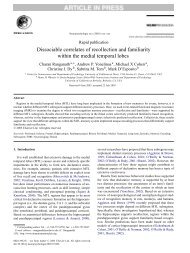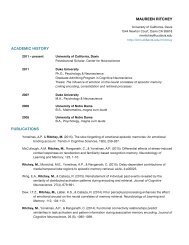CLINICAL EEG and NEUROSCIENCE - Dynamic Memory Lab
CLINICAL EEG and NEUROSCIENCE - Dynamic Memory Lab
CLINICAL EEG and NEUROSCIENCE - Dynamic Memory Lab
Create successful ePaper yourself
Turn your PDF publications into a flip-book with our unique Google optimized e-Paper software.
<strong>CLINICAL</strong> <strong>EEG</strong> <strong>and</strong> <strong>NEUROSCIENCE</strong> ©2007 VOL. 38 NO. 1Spatial-Temporal Current SourceCorrelations <strong>and</strong> Cortical ConnectivityR. W. Thatcher, C. J. Biver <strong>and</strong> D. NorthKey WordsCortical ConnectionsCortico-cortical Connectivity ModelIntra-hemispheric AsymmetryLORETASource CorrelationsABSTRACTThe purpose of this study was to explore spatial-temporalcorrelations between 3-dimensional current density estimatesusing Low Resolution Electromagnetic Tomography(LORETA).The electroencephalogram (<strong>EEG</strong>) was recorded from19 scalp locations from 97 subjects. LORETA current densitywas computed for 2,394 gray matter pixels. The graymatter pixels were grouped into 33 left hemisphere <strong>and</strong> 33right hemisphere regions of interest (ROIs) based ongroupings of Brodmann areas. The average source currentdensity in a given region of interest (ROI) was computedfor each 2 second epoch of <strong>EEG</strong> <strong>and</strong> then a Pearson productcorrelation coefficient was computed over the timeseries of successive 2 second epochs of current densitybetween all pairwise combinations of ROIs during the restingeyes-closed <strong>EEG</strong> session.Rhythmic changes in source correlation as a function ofdistance were present in all regions of interest. Also, maximumcorrelations at certain frequencies were presentindependent of distance. The occipital regions exhibitedthe highest short distance correlations <strong>and</strong> the frontalregions exhibited the highest long distance correlations. Ingeneral, the right hemisphere exhibited higher intra-hemisphericsource correlations than the left hemisphere especiallyin the temporal, parietal <strong>and</strong> occipital cortex. Thestrongest left vs. right hemisphere differences were in thealpha frequency b<strong>and</strong> (8-12 Hz) <strong>and</strong> in the gamma frequencyb<strong>and</strong> (37-40 Hz).The pattern of spatial frequencies in different corticallobules is consistent with differences in neural packing density<strong>and</strong> the operation of ‘U’ shaped fiber systems. The generalconclusions were: 1- the higher the packing densitythen the greater the intra-cortical connection contribution toL O R E TA source correlations, 2- spatial frequencies are primarilydue to intra-cortical ‘U’ shaped fiber connections <strong>and</strong>long distance fiber connections, 3- posterior <strong>and</strong> temporalcortical intra-hemispheric coupling is generally stronger inthe right hemisphere than in the left hemisphere.INTRODUCTIONNeural dynamics involves the generation of electricalcurrents by populations of synchronously active neuronswithin local regions of the brain which are coupled throughaxonal connections to other populations of neurons. 1 - 4Anatomical analyses of the cerebral white matter haveshown that there are three general categories of corticocortcalconnections: 1- intra-cortical unmyelinated connectionswithin the gray matter on the order of 1 mm to approximately3 mm, 2- short-distance ‘U’ shaped fibers in thecerebral white matter located beneath the gray matter (10mm to approx. 30 mm) <strong>and</strong>, 3- long distance fasciculi locatedin the deep white matter below the ‘U’ shaped fibers withdistances from 30 mm to approx. 170 mm. 3 , 4 Measures of<strong>EEG</strong> coherence <strong>and</strong> phase delays from the scalp surfacecommonly detect the presence of two compartments withan approximate correspondence with the short distance<strong>and</strong> long distance fiber systems. 1 , 2 , 5 - 7 For example, studiesby Nunez 1 <strong>and</strong> Thatcher et al 5 showed that <strong>EEG</strong> coherencedecreases as a function of distance from any electrode site,thus characterizing the short distance compartment <strong>and</strong>coherence increases as a function of distance beyondapproximately 10-14 cm, which characterizes the long distancecompartment. Studies of changes of <strong>EEG</strong> coherencewith distance are usually explained by a decrease in thenumber of connections as a function of distance from anygiven population of neurons, while increased coherencewith distance is explained by an increase of connectionsbetween two populations through axons <strong>and</strong> fasciculi of thedeep cerebral white matter. 1 - 6A deeper underst<strong>and</strong>ing of cortical coupling is possibleby studying the correlations between current sourcesderived from the surface <strong>EEG</strong> using an inverse method. 8 - 1 0Thatcher et al 8 recorded <strong>EEG</strong> during voluntary finger move-From the Department of <strong>EEG</strong> <strong>and</strong> NeuroImaging <strong>Lab</strong>oratory (R. W.Thatcher, C. J. Biver, D. North) Bay Pines VA Medical Center, St.Petersburg, Florida, <strong>and</strong> the Department of Neurology (R. W. Thatcher),University of South Florida College of Medicine, Tampa, Florida.Addresss requests for reprints to Robert W. T h a t c h e r, PhD,NeuroImaging <strong>Lab</strong>oratory, Research <strong>and</strong> Development Service-151,Veterans Administration Medical Center, Bay Pines, Florida 33744, USA.Email: rwthatcher@yahoo.comReceived: February 13, 2006; accepted: May 14, 2006.35




